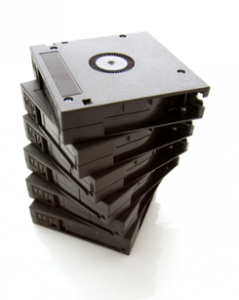
Does your company have volumes of backup tapes in your data center or offsite? If your company is at the end of a data retention period, or is ready to release or purge old archived data, you may come across hundreds or even thousands of tapes that contain important company data. Knowing what procedure is best to sanitize all of this data is crucial. There are two main options: physical destruction, and data destruction. One method may be better for you than the other depending on your company, the type of data, where it’s stored, and how many tapes you need to securely sanitize.
Physical Destruction – Shredding
This is the ‘brute force’ option for data destruction. With this method, tapes are shredded, leaving the media unusable and scattered into small individual pieces that cannot be made whole again. With this method, the data on the tapes themselves remains intact. This usually won’t matter, though, since reconstructing a shredded tape would be nearly impossible. It does make a mess, though. The volume of a tape increases by 4x after shredding.
Data Destruction – Degaussing
Degaussing is the only completely reliable way to sanitize data on magnetic storage media and is approved by the NSA and other major government agencies. The process eliminates the remnant magnetic field which holds the information on storage media such as tapes and hard drives.
Although degaussing leaves the media physically intact, the process will securely and completely sanitize the media and renders it useless when done correctly. LTO and DLT tapes contain a factory-written magnetic servo signal that is destroyed along with the data during the degaussing process. One advantage of not physically destroying the media is that it is much easier to store and transport after the process is complete. A degaussed tape takes up the same amount of space it did before the data was destroyed, allowing the tapes to be transported or stored in containers. A good way to dispose of the degaussed tape is via an incinerator used for power generation. There are a number of these facilities around the country, though not in every state.
Know your degausser! Though handheld degaussers exist, they are slower and require a specific procedure to ensure full data destruction. They are also made for use on hard drives, and should not be used for degaussing tapes! Conveyor degaussers are able to wipe media in a continuous stream, and some are able to process nearly 2,000 tapes or hard drives per hour. Conveyors are also mobile, and the process can be performed inside of offices, data centers, storage locations, and more. All that is needed is a 120V power source and adequate space.
To learn more detailed information about the process of degaussing, request our degaussing technical brief. In it, you’ll learn more about NSA standards for degaussing and data destruction, Oersteds and Coercivity, and why not all degaussers are created equal. Contact us or call (888) 720-0900 to request your copy today

